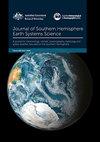Extraordinary sequence of severe weather events in the late-nineteenth century
IF 3.6
4区 地球科学
Q1 Earth and Planetary Sciences
引用次数: 5
Abstract
Between 1883 and 1898, 24 intense tropical cyclones and extra tropical cyclones directly impacted on the southern Queensland and northern New South Wales coasts, with at least 200 fatalities in what was then a sparsely populated area. These events also caused record floods and rainfall, for example Brisbane City experienced its two largest ever floods over this period and Brisbane City set a 24-h rainfall record that still stands today. Additionally, a 24-h rainfall total of 907mm occurred in a tributary of the upper Brisbane River resulting in a 15-m wall of water advancing down the river. Recent studies have shown that this part of Australia incurs the largest weather-related insurance losses. A major focus in this study is the seas these storms generated, leading to the loss of many marine craft and changes these waves brought to coastal areas. As a famous example of coastal erosion near Brisbane, the continual impacts from large waves caused a channel to form through Stradbroke Island to the open ocean forming two separate islands. Details of how this channel formed are described in relation to the storms. A climatology study of 239 Australian east coast storms that caused severe ocean damage between Brisbane and the Victorian border over the period between 1876 and February 2020 showed that 153 events occurred with a positive Southern Oscillation Index (SOI) trend and 86 events with a negative trend. The most active years were 1893 and 1967, both during positive SOI periods and both dominated by tropical cyclone activity. The 1893 events caused unparalleled floods and strongly contributed to the Jumpinpin breakthrough on Stradbroke Island, and the 1967 event was associated with historical Gold Coast beach erosion causing 9 billion normalised Australian dollars of insurance losses. The study also showed how direct tropical cyclone impacts in the study area decreased markedly following the June 1976 climate shift.19世纪晚期一系列异常恶劣的天气事件
1883年至1898年间,24个强烈热带气旋和超强热带气旋直接影响了昆士兰州南部和新南威尔士州北部海岸,在当时人口稀少的地区,至少有200人死亡。这些事件还造成了创纪录的洪水和降雨,例如布里斯班市在此期间经历了有史以来最大的两次洪水,布里斯班市创造了24小时降雨记录,至今仍保持不变。此外,布里斯班河上游的一条支流24小时总降雨量达907毫米,造成15米高的水墙向下游推进。最近的研究表明,澳大利亚的这部分地区遭受的与天气有关的保险损失最大。这项研究的一个主要焦点是这些风暴产生的海洋,导致许多海洋船只的损失,以及这些海浪给沿海地区带来的变化。作为布里斯班附近海岸侵蚀的一个著名例子,大浪的持续冲击导致一条海峡形成,穿过斯特拉德布鲁克岛到开阔的海洋,形成两个独立的岛屿。这条通道如何形成的细节与风暴有关。对1876年至2020年2月期间在布里斯班和维多利亚边境之间造成严重海洋破坏的239次澳大利亚东海岸风暴进行的气候学研究表明,153次事件发生了正的南方涛动指数(SOI)趋势,86次事件发生了负趋势。最活跃的年份是1893年和1967年,均处于SOI正期,且均以热带气旋活动为主。1893年的事件造成了前所未有的洪水,并在很大程度上促成了Stradbroke岛的Jumpinpin突破,1967年的事件与黄金海岸历史上的海滩侵蚀有关,造成了90亿澳元的正常保险损失。研究还表明,1976年6月气候变化后,研究区热带气旋的直接影响显著减少。
本文章由计算机程序翻译,如有差异,请以英文原文为准。
求助全文
约1分钟内获得全文
求助全文
来源期刊

Journal of Southern Hemisphere Earth Systems Science
Earth and Planetary Sciences-Oceanography
CiteScore
8.10
自引率
8.30%
发文量
0
审稿时长
>12 weeks
期刊介绍:
The Journal of Southern Hemisphere Earth Systems Science (JSHESS) publishes broad areas of research with a distinct emphasis on the Southern Hemisphere. The scope of the Journal encompasses the study of the mean state, variability and change of the atmosphere, oceans, and land surface, including the cryosphere, from hemispheric to regional scales.
general circulation of the atmosphere and oceans,
climate change and variability ,
climate impacts,
climate modelling ,
past change in the climate system including palaeoclimate variability,
atmospheric dynamics,
synoptic meteorology,
mesoscale meteorology and severe weather,
tropical meteorology,
observation systems,
remote sensing of atmospheric, oceanic and land surface processes,
weather, climate and ocean prediction,
atmospheric and oceanic composition and chemistry,
physical oceanography,
air‐sea interactions,
coastal zone processes,
hydrology,
cryosphere‐atmosphere interactions,
land surface‐atmosphere interactions,
space weather, including impacts and mitigation on technology,
ionospheric, magnetospheric, auroral and space physics,
data assimilation applied to the above subject areas .
Authors are encouraged to contact the Editor for specific advice on whether the subject matter of a proposed submission is appropriate for the Journal of Southern Hemisphere Earth Systems Science.
 求助内容:
求助内容: 应助结果提醒方式:
应助结果提醒方式:


